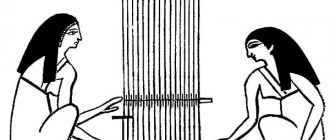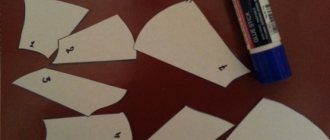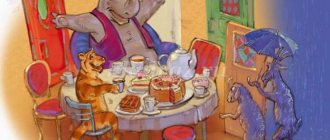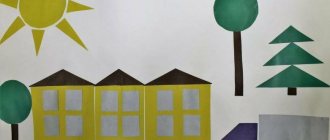The purpose of the didactic game “Living and Nonliving”
The game is aimed at the cognitive development of preschoolers on the topic “Ecology”; it fosters interest and respect for natural objects.
The goal is to expand and consolidate ideas about nature, develop the skill to distinguish between living and inanimate objects, and find connections between them.
Tasks:
- developing the ability to identify objects of living and inanimate nature, as well as man-made ones;
- improving speech skills;
- learning the skill of formulating questions and answering them;
- enrichment of individual thematic vocabulary;
- training in the skills of solving emerging problems and formulating conclusions;
- developing an interest in nature and a desire to positively influence the environment;
- fostering curiosity and cognitive interest;
- development of memory, creative and logical thinking, concentration.
Lithosphere
Lithosphere
Planet Earth itself is considered an inanimate object. However, it is the only planet studied so far on which life exists in the form in which we see it. The planet arose billions of years ago thanks to a fortunate coincidence; its current position in the solar system ensures the comfortable existence of organisms on its territory.
The structure of the earth is not only its outer shell. In the very center there is a core filled with red-hot metal compounds. On top of the core is the molten mantle, its layer is extremely thick, much larger than the soil layer. Evolutionary processes affected not only living nature, continents constantly changed their position, mountains and oceans arose.
Interesting: Why are there no ebbs and flows in the Black Sea?
At the moment, there are 6 continents, but long before the advent of humanity there was only one continent. The relief on each part of the planet is different, as are the climatic conditions. Each zone has its own characteristic features; it is home to certain species that are unique to it.
In addition, there is wealth in the depths of the Earth. Minerals make human life much easier, extending its duration and developing cities, countries and settlements.
Middle group
Before conducting a lexical game, it is necessary to remind students that the answer to the question “Who is this?” indicates a living object, and the question “What is this?” - on an inanimate object. For the game, prepare electronic, if you have a player, or paper images of living and inanimate objects, as well as green round and triangular blue marks.
Scroll through the images on the presentation screen, and preschoolers should say which object they see - living or inanimate, and which of the above questions needs to be answered. For example, seeing a cat on the screen, players say: “Who is that? - Cat". Then they discuss the animal and why it belongs to wildlife. Or an image of a stone appears on the screen. This is inanimate nature, for which the question “What is this?” should be asked.
Natural phenomena
Metamorphoses are also called natural phenomena (what is this?). For example, in the spring leaves grow on trees, and in the fall they fall off. After the rain, a rainbow appears in the sky and mushrooms grow. In winter it snows, together with the wind forming a blizzard or blizzard.
All this and much more are natural phenomena, the totality of which is divided into classes :
- by origin (climatic, cosmic, geological, biogeochemical, geomorphological) - tsunamis, hurricanes, earthquakes, precipitation, lightning, solar and lunar eclipses, etc.;
- by duration (instant, short-term, long-term) - volcanic eruption, icicles, drying out of a river bed, etc.;
- by regularity of action (daily and seasonal) - sunrise, bud opening;
- by scale of distribution;
- by the nature of the impact (favorable, unfavorable). For example, natural disasters can be very destructive - floods, tornadoes, etc.
Senior group
For the game, intended for preschoolers 5–6 years old, you need landscape-size cards and small images of natural objects. The cards should display the questions “Alive?” and “Inanimate?”, “Who?” So what?". The didactic game “Living and Inanimate Nature” teaches you to ask questions in detail and competently, and to give a clear and correct answer. At older preschool age, the child should already be able to talk in sufficient detail about what he saw and describe the images. The game helps you gain the skill of composing a narrative according to a plan.
For one lesson, take as many images as will not tire your preschooler. Show pictures one by one and ask what is shown on them. The player’s task is to answer the above questions, point with a finger at the correct answer, tell about the depicted object, what it looks like, what it does. The game can be made competitive if several children participate, then each player receives a badge for correct answers.
Here are examples of questions from the teacher and the player’s answers:
- "Who is this?" - “Dog” - “Is she alive?” - “Live” - “What is the dog doing?” - “Barks, runs, bites, wags its tail, sniffs, plays”;
- "What is this?" - “Tree” - “Is it alive?” - “Living” - “What does a tree do?” - “It grows, blooms, rustles its branches, bends in the wind”;
- "What is this?" - “Stone” - “Is he alive?” - “Not alive” - “What does a stone do?” - “Lying.”
Integrated lesson on ecology and applications in the senior group. "Interesting Clouds"
Integrated lesson on ecology and applications in the senior group.
"Interesting Clouds"
Target:
Continue to introduce children to natural phenomena.
Form an idea of clouds, conditions of formation, meaning.
Teach to see beauty in the world around us and treat nature with care.
Develop observation, attention, memory, creative imagination, fine motor skills.
Equipment:
Laptop, table “Water cycle in nature”, presentation “Amazing clouds”, Whatman paper, cotton wool, PVA glue.
Preliminary work
.
1. Lessons to familiarize yourself with the outside world.
2. Reading fiction.
3. Observations during a walk in the kindergarten territory.
Progress of the lesson.
Organizing time. Unnoticed by the guys, a winged pony flies in to visit.
Educator: Listen carefully to the riddle; solving it is the theme of our lesson.
They fly above the ground and rest on the peaks. Water pours down from them like rain, Snow and ice sometimes. Life is beautiful and easy, If you live on...( Clouds )
Educator: Today we will talk about a natural phenomenon - clouds.
- Where are you going, clouds ? And most importantly, where from? -Where are we from? From afar! And we go everywhere. We are there - and here, We are here - and there. We obey the winds: They blow to the north - we go there, To the south - please, always. And here it is night, it’s time for you to sleep, And the winds are calling us with them. And there are no wings, but we are flying, And we don’t even sleep at night, And there is no corner in the world Wherever there are clouds.
– So what are clouds? How do you think? What are they like?
Children's answers.
Educator: That's right, if you look closely they always change and even take on the shape of various animals and natural images!
A cloud is light gray puffs, wavy layers in the sky, a cluster of water droplets and ice crystals.
Clouds are formed in the following way (showing a diagram of the water cycle in nature).
Water evaporates on the ground, in the form of water vapor, and rises up into the atmosphere. Water vapor mixes with air. Here it cools down. Inside the cloud, tiny droplets become larger and larger. Then the drops become so large that they cannot stay at the top, and fall to the ground in the form of precipitation. This phenomenon is called the water cycle in nature.
Physical exercise “Cloud”
White cloud (Rounded hands in front of you)
Rising above the roof (Raise your arms above your head)
The cloud rushed
Higher, higher, higher (Pull your arms up; smoothly swing your arms above your head from side to side)
The wind caught this cloud on the steep slope.
The cloud turned into a thundercloud (Use your hands to describe a large circle downwards from the sides and lower them; sit down).
Educator: Now guys, we’ll look at the beautiful clouds. Let's see and try to guess what shape they took, let's dream a little with you.
Screening of the presentation “Amazing Clouds”.
Slide 1 – Title “Amazing clouds”.
Slide 2 – poem
Clouds floated across the blue sky,
Similar to a cake, pillow and elephant.
Playing with the breezes, they changed their appearance.
How I wish they would take me with them.
Slide 3 – Bird-shaped cloud
The teacher asks a riddle. The guys look and offer their options. This bird is a symbol of peace,
She can't sit still,
He carries letters on himself,
And it is always valuable!
Answer: Dove
The guys look and offer their options.
Preparatory group
The game teaches you to distinguish between natural objects and objects created by human hands. Preschoolers gain the skills of classification, description, reasoning, and drawing conclusions. The game can be individual based on the “teacher and child” principle or group.
It is necessary to prepare images of natural and man-made objects. Place pictures of man-made objects in front of the children. Show images of natural objects one by one, and students must find among man-made objects those that are similar in purpose or appearance. For example, after seeing a picture of a beehive, children can choose a picture of a human house, a chicken coop, or a barn.
Here are more examples of similar natural and man-made objects for play:
- cobweb - mesh, lattice, gauze, napkin with lace;
- flying bird - airplane;
- sun - lamp, lantern, spotlight;
- field mouse - computer mouse;
- den - bedroom, kennel;
- wind - fan, hairdryer;
- insect butterfly - bow tie;
- hedgehog - brush, comb;
- crustacean claws - pliers, pliers;
- bell plant - musical instrument bell;
- giraffe - crane;
- fish - submarine;
- caterpillar - train;
- dragonfly - helicopter.
It is important that the child not only select objects that are similar in certain characteristics, but also explain in detail how they are similar and why he made this particular choice. For example, a hedgehog has densely arranged needles on its back, similar to teeth protruding from a comb.
Microorganisms
Microorganisms
Microorganisms can rightfully be considered the first living beings on the planet. They originated long before the appearance of humanity and even animals. This is the longest living form of life.
Microorganisms originated millions of years BC, however, having come such a long way, they are still the most common forms of life. They can be found in every ecosystem. Microorganisms are microscopic single-celled creatures found absolutely everywhere. They cannot be seen with the naked eye, but a microscope is used to study them. Among the wide variety are bacteria, fungi and viruses.
The survival rate of microorganisms is simply colossal - they do not care about almost all environmental conditions. These creatures can be found in hard rocks. The main feature of microorganisms is intensive reproduction in favorable conditions. Genes are transmitted horizontally - they do not need to pass on genetic data to descendants to spread their influence.
Development occurs thanks to other living beings. This factor is decisive in any habitat. Some types of microorganisms survive even in the vacuum of space.
There are dangerous and beneficial microorganisms. Thanks to the latter, life on the planet develops, but the harmful ones only worsen the situation, destroying everything around. Sometimes harmful microorganisms are beneficial - some viruses can cure serious illnesses in people.
Interesting: How did the Earth's surface change? Description, photo and video




